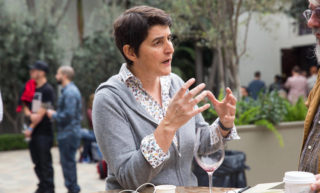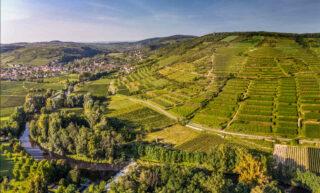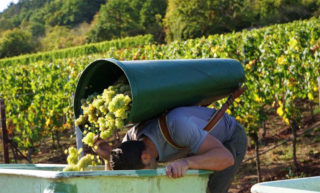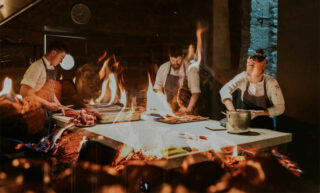Claus Preisinger’s experimental approach to wine
If Austria has a natural wine capital, it may well be Gols. It is the hometown of Pannobile, a group of nine vintners who are farming mostly biodynamically and make their wines with little intervention. After I moved to Vienna two years ago, the first three wines I tried, recommended by three independent sommeliers, turned out to be Pannobile wines. Claus Preisinger’s vin de soif “Puszta Libre!” was one of them; all were outstanding. Ever since I follow the group closely. I met Claus at his winery, which is as lean, harmonious and respectful for its environment as his wines.
It was a typical winter day when I drove eastwards from Vienna on the Ost Autobahn towards the Hungarian border. The endless basin of the Central-European Puszta was filled with monotonously gray low hanging clouds. But when I left the highway a faint silvery light broke through, which, upon arrival at Weingut Claus Preisinger, mixed with the first sparks of gold.
Seen from the front, the concrete building, partly clad in wood, is somewhat like a submarine, the overhanging terrace with floor-to-ceiling windows across its entire width resembling the eye. Behind its façade the building spills over the flanks of the Goldberg, its roofline following the downward inclination of the hill. It stands out and simultaneously blends magnificently into its environment, a subtly undulating plateau planted with vines as far as the eye can see. From the terrace, the silhouette of a former grain silo, built deliberately higher than the church to underline the power of agriculture, stands not far from the impressive Lake Neusiedl.
Ten years old, but still strikingly modern, Preisinger’s medium-sized winery produces 150,000 bottles on average per year. Just like the building, the white labels, carrying only Preisinger’s first name in barely legible handwriting, are timeless and minimalist. A smiley-face emoji with its tongue out, winking to the wine authorities, gracing the cap on Claus’ wines, along with inventive ways of disguising the vineyard’s name and the grape variety on the label to circumnavigate the strict rules defining Austrian Qualitätswein, are two of his trademarks.
Claus, 39 years old and with a full head of dark hair and a matching beard, is from an agricultural family where wine was a side-product. Raising horses was his father’s passion and core business. Not surprisingly, Preisinger Sr. dreamt of his son as an Olympic equestrian champion or, second best, having a career at the famous Spanish Riding School. But for young Claus, polishing riding boots and cleaning out stables wasn’t exactly his dream. Instead, he went to the Klosterneuburg Weinbauschule, the illustrious viticultural school just north of Vienna, at the tender age of fourteen. Pooling together their pocket money, he and his classmates at the boarding school, started buying and tasting wines such as Nebbiolos from Piedmont and Pinots from Burgundy that were the nec plus ultra for them.
His first job brought him to California. “More fun than work,” he admits. It was far removed from the way he makes his wines now: His first task at Limerick Lane winery in Sonoma was to dilute some Zinfandel with water. But Gols kept on pulling; and so his next station was at Hans and Anita Nittnaus’ winery in his hometown, where he really learned the tricks of the trade.
Initially, Claus produced wine mainly in small barrels, but over time he replaced them with bigger wooden vats and amphorae, all in a quest to make his wines as pure as possible. Currently he is planning to shift to even larger wooden barrels to further minimize the impact of wood on wine. Three new oval 2000-liter oak vats were awaiting their inauguration when I visited. “I search for neutral barrels. These are untoasted,” Claus says when I peek inside one of them. “I first clean them with warm water and then use them for some bulk rosé that I can’t use for my own label. This way the strongest tannins are leached out, before I start using them for the maturation of my own wines after the next harvest.”
While still working and training at Nittnaus, Claus started off with two parcels of his own. Over the years, his winery in the Austrian state of Burgenland has grown to thirty hectares, ten of which are on long-term lease and ten are contracted. Burgenland forms the western fringe of the Pannonian Basin, named after a province of the Roman Empire in what is now Central Europe. Lake Neusiedl, once a part of the Pannonian Sea, responsible for marine, calcareous deposits, is the main geographical feature of northern Burgenland. The Leitha Mountains on the west side of the lake, and the plateau on the north side where the winery is based, provide cooler climactic conditions. Wines from here typically have more freshness. Seewinkel, the area on the eastern side of the lake is low and flat, and tends to be hot and humid in summer, ideal circumstances for Botrytis prone grape varieties, thus making it the heartland for Austrian sweet wine. Claus’ vineyards form a loose chain of plots that run from the Leitha Mountains towards Seewinkel.
The vineyards are farmed in accordance with the cycles of the moon—the most difficult part of biodynamics for me as writer to understand. But Claus’ approach is as simple as it is convincing: “If the cycle of the moon can cause the oceans to ebb and flow, how would it not affect my vineyards and my winemaking?” For Claus, farming biodynamically is traditional, rather than modern. Older generations cut their trees and, as Claus explains, even their hair depending on the phase of the moon. “Industrialization wiped out most of this knowledge; I want to retrieve it.”
Back in the mid-Aughts, Claus switched to biodynamic farming almost overnight. Cover crops and and plant-based teas to spray the vines were introduced. Proudly, he shows me his oversized “teapot.” In the human-sized steel tank, he brews his chamomile and horsetail concoctions. He also tried ginger. “When it’s good for humans, it is good for my vines.”
Claus Preisinger in front of his "teapot"
Claus doesn’t shun experimentation. “I am easily bored,” he says. “That is why I always push myself. I don’t like when vintners say they still do everything the same way their grandfather did. You have to do it your own way.” Claus is self-made; he doesn’t stand in a tradition of generations of dedicated winemakers. “I am the new world in the old world,” he summarizes succinctly.
As we wander into the vineyards on the plateau behind the winery, Claus squats down at a heap of earth, another of his experiments. “My own compost,” he says. Made of dung from his father’s horses, the leftover pomace from the wine production, straw, hay, some cow manure bought from a neighboring farm and biodynamic preparations, it looks black, lush and incredibly fertile. After three years of decomposition, the compost – the word fertilizer is carefully avoided – is ready to use, which he does sparingly, only in places where there is a need to supplement the natural soil. In the vineyards too, Claus intervenes as little as possible. Canopy management exists mostly of curling up the twigs and leaves of too vigorous vines between the wires of the trellises, rather than cutting them. “Pruning stimulates the growth. I want the vine to put the energy into the grapes,” Claus explains.
Back in the cellar, he shows me another experiment, a cider and wine blend, made of two-thirds Bouvier, a local white cross-breed of Muscat à Petits Grains and an unknown Pinot variety, and one-third Steirische Bohnapfel, a type of apple that he got from a friend. “The apple cider had two weeks of skin-contact, a tad too long,” he says. Next year he will try again. It’s nonetheless a refreshing and complex drink that could serve as an outstanding aperitif.
My next sip comes from one of his first amphorae that turned out to be too porous and has been roughly plastered over with cement. It is as if time has given it an age-old patina, but Claus doesn’t like it. “I prefer the newer amphorae,” he says while he gently strokes the smooth surface of one of them.
The old amphorae contain a golden wine of Scheurebe grapes, a Riesling cross-breed, from two vineyards – one schist, one limestone -, giving it electricity and some graininess. One half destemmed and one half whole bunch, the carbonic maceration, where carbondioxide from conventional fermentation pushes out the oxygen and stimulates intercellular fermentation in the unbruised grapes, underlines the aromatic character of the grape.
Claus studies the different types of amphorae for their impact on the wines. One thing is certain; none of them is completely neutral. While I thought the Scheurebe had a chalky undertone from the limestone soil, Claus believes the amphora reinforces this flavor.
Claus Preisinger and his wines
Although Lake Neusiedl is a Zweigelt appellation according to Austrian wine law, Claus has shifted mostly towards Blaufränkisch. He thinks this grape is a better expression of the area. Out of the ten 2018 wines I tasted, six are made of the Blaufränkisch grape, one of them being his Frank Cornelissen inspired “Dope” fizzy rosé. The real dope, however, is a small amount of weed-fermented wine in a demi-john covered with a layer of flor. Since he gave up smoking, he says, this is his guilty pleasure.
Although there are remarkable differences in character, ranging from fruity, cluster-fermented to spicy Syrah-like to concentrated and floral, if there is a common denominator for Claus’ wines, it is their precision and their lean and linear character. It epitomizes his overall “less-is-more” approach. “Wine is a living product; it changes all the time. It is hard to find the right moment to intervene, hence it’s better not to intervene at all.”
Over lunch, looking out on the meanwhile sun-drenched vineyards, Claus tells me that he travels often to meet his clients. Now that he has a young son, he tries to stay home more. When he drives back from Vienna airport, leaves the highway and descends towards Lake Neusiedl, he feels strongly his connection to this small part of the world. Some tension in his voice reveals that he is both angry and sad that the wine authorities still don’t recognize his wine, or any natural wine for that matter, as Qualitätswein. Being attached to Gols and Burgenland as he and his wines are, he would love to put the wines’ origin on the label. For now he has to rely upon his signature and the power of creativity to disclose the name of the vineyards. Fortunately, he has that in abundance.
A slightly adjusted version of this article has been published in Pipette issue 3, 2019.







Comments